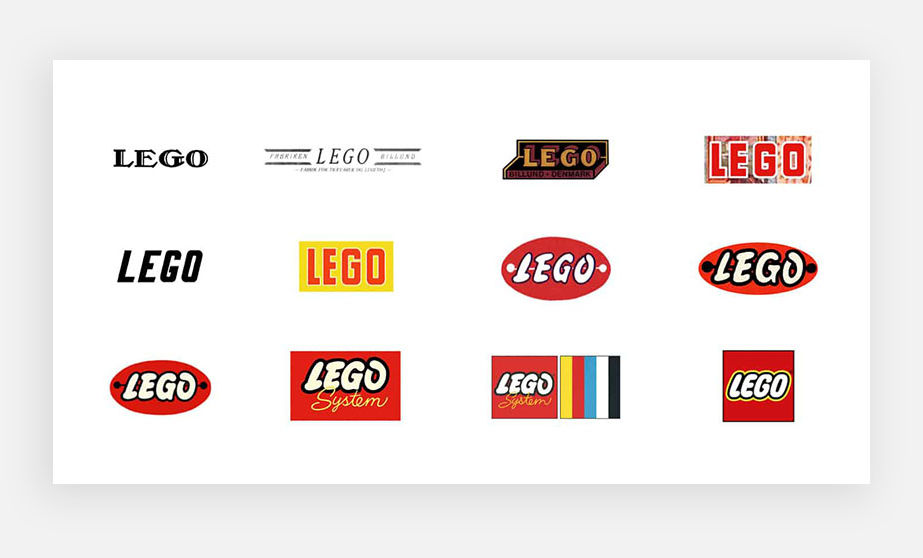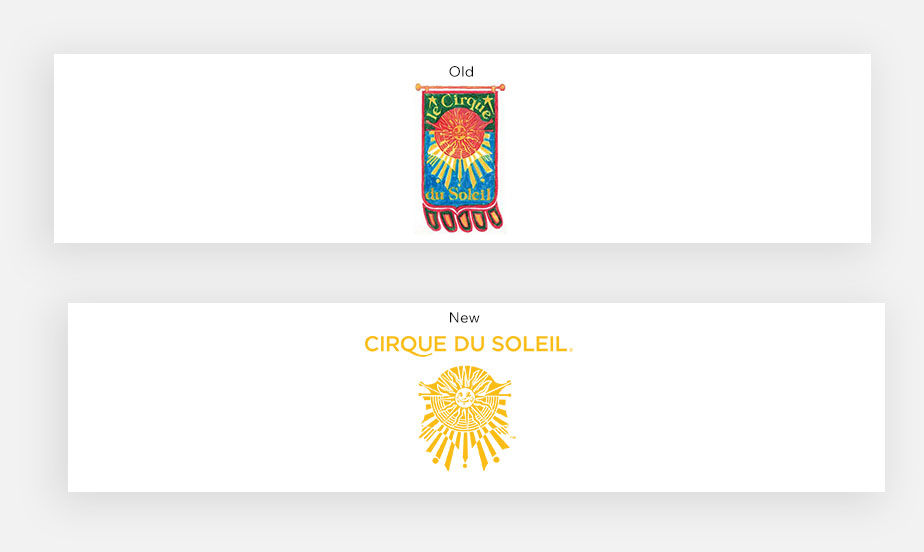20 most famous brand logos with fun facts
Some logos get all the attention, but there’s a good reason for that. Most famous logos we know today are a result of the great stories, big dreams and creative minds behind the brand.
Of course, there’s a lot of strategic thinking that goes into creating a logo that makes an impact. The companies we discuss in this article had manifold considerations when seeking inspiration for the perfect logo, such as: the psychology of their consumers, their brand’s core values and the message they want to send to customers.
As you look for logo inspiration of your own, set your eyes on these 20 famous logos, with 20 fun facts that might surprise you. By the way, you’ll notice that many of these company logos didn’t get famous on their first try. They did, however, continue working until they achieved the influential logo design they have today.
01. Amazon
Amazon founder Jeff Bezos has been involved with each iteration of the brand’s famous logo design, turning to designer Turner Duckworth to get the job done. Today’s versatile Amazon logo was introduced in the year 2000. It features a wordmark of the brand’s name with one simple, yet distinguished, design element: a smile made out of an orange arrow.
Fun fact: The smile has two clever meanings. First, the line starts at the letter “A” and ends at the letter ”Z” to represent the fact that Amazon will deliver anything from point A to point Z. The smile illustration was used to evoke the smiling face of customers when they receive an Amazon package at their doorstep.

02. Disney
In an ode to childhood, fun and entertainment, the Disney logo reminds us of the magic envisioned by founder Walt Disney. The iconic Disney castle was first introduced to the logo in 1995, and in 2006 the emblem was, with the help of Pixar, given a stunning dose of technological advancement by turning it 3D.
Fun fact: Is it Disney’s very own signature? Not exactly. Although this “handwriting” is a stylized version of the founder’s, Disney changed his signature so often that it was impossible to pin-down by designers.
In the words of Walt Disney collectibles expert Phil Sears, “Walt consciously re-designed his signature over the years, in much the same way he changed the appearance of Mickey Mouse over time. Walt’s signature will look different for every decade, and then there are differences within each decade.”
03. Nike
The Nike swoosh is perhaps the most famous logo symbol in the world of sports. Upon its creation, brand owner Phil Knight had one goal in mind: a simple logo design that conveys motion and speed. Part of knowing how to design a logo is setting yourself apart from competitors. In the case of Nike, they wanted to distinguish themselves from Adidas, one of their biggest competitors at the time.
Carolyn Davidson was the designer that answered his call, making history with the swoosh that we all know today. The swoosh is a powerful logo symbol that stands on its own, inspired by the wing of Nike, the Greek goddess representing victory.
Fun fact: When the Nike branding team original chose the swoosh, Knight said he “didn’t love it, but it will grow on me.”
04. McDonald’s
McDonald’s “golden arches” is a restaurant logo that works so well, it’s matured into a cultural icon of its own.
Since its official birth, the McDonald’s logo has undergone several revamps, its most recent by Heye Partner in 2003. Today, the modern logo is simple, yellow (with the occasional accompaniment of bright red), and often paired with the slogan, “I’m lovin’ it.”
The McDonald’s logo is recognized across the globe, and has become a symbol of fast food dining. What started out as a small burger joint in San Bernardino, California has accomplished one of the greatest feats of logo design and branding.
Fun fact: Where do those arches come from? The first McDonald’s restaurant was opened by Richard and Maurice McDonald in 1937. But it was only in 1952 that the arches were first introduced to the brand.
With the opening if it’s first franchised store, the new building included stylized half circles by sign-maker George Dexter. The arches were added to the structure to form the letter “M,” and Ray Kroc incorporated them into the restaurant’s new corporate logo when he bought McDonald’s in 1961.
05. Gucci
Whether we can afford it or not, the Gucci logo has embedded its famous glow into our consumer minds. And it’s done so with class, too.
Guccio Gucci started the fashion brand in 1921 with luxury on his mind, but it wasn’t until 1933 that the fashion house made the decision to design a logo. The brand, whose logo features a lettermark of double interlocked “Gs,” eventually welcomed additional designs into their branding repertoire as well.
1951 marks the year Gucci’s red, white and green ribbon emblem was incorporated into their designs. Honoring the founder’s home country of Italy, the color combination is often used side-by-side the logo on various clothing and bag designs. In 2015, a slight makeover was also introduced to the iconic logo, turning the double G’s to face the same way.
Fun fact: The famous lettermark logo was created by Gucci’s son, Aldo, to represent his father’s initials. Further emphasizing extravagance, it is also said to symbolize the links of a bracelet.
06. Chupa Chups
The Spanish lollipop company’s logo is especially unique since it was designed by the famous surrealist artist, Salvador Dalí in 1969. He chose to create a bright colored daisy design to draw attention, but also because it fits perfectly on top of a round lollipop when centered on the wrapper of the candy’s packaging. Mr. Dali suggested this placement, since it is always prominent.
Fun fact: The company’s name comes from the Spanish verb “chupar,” which means to “lick, or suck” or in English.
07. Coca Cola
This logo needs no introduction. Coca Cola has kept a similar version of its original logo design since the beginning of the company’s existence in 1886. The Spencerian script is full of elegance and represents the classic handwriting of the time.
Although it’s been slightly revised since, Coca-Cola has stayed true to its classic style. The bright red colors and signature are so distinguished, that when translated across languages, consumers can still recognize it worldwide.
Fun fact: This famous script logo was actually designed by the founder’s bookkeeper, Frank Mason Robinson who suggested that the two “C”s would look fabulous in advertising.
08. Google
Google’s logo is quite simple considering it’s one of the most recognized brands in the world. So well known that its name has become synonymous with the verb “search.” Designer Ruth Kedar originally made the wordmark using a Baskerville Bold font, but it has since been refashioned into a flatter design, using a sans serif typeface created in-house.
Since it’s a logo that lives and breathes innovation and information, the Google logo is every now and then transformed into a Google Doodle to commemorate holidays, notable events and figures, and more.
The wordmark design originally used Baskerville Bold font, but has since evolved into a flatter design with a sans serif typeface created in-house.
Fun fact: The logo’s color palette – primary color with a rogue green “L” – was chosen with founders Larry Page and Sergey Brin, who wanted to express a message that their company doesn’t play by the rules, but prefers to break them.
09. Instagram
Instagram has not been around for a long, therefore many of us can remember the brand’s original logo from 2010. It was an image of a camera which encompassed plain, tan and brown colors to cater to an audience of mainly photographers. However, in 2016 Instagram decided to have a makeover when they realized how much their audience had diversified over a short span of time.
Users were no longer just photographers, rather they included Millennials, Generation Z, and some of the most powerful brands and influencers. The bright, vibrant colors of the current logo and its ombre style are meant to reflect the spirit of this app’s unfolding and vastly diverse audience.
Fun fact: The original logo was designed by Instagram CEO Kevin Systrom himself.
10. Dove
Dove is a company that does so much good with their name and classic toiletries. The logo, created by Ian Brignell, combines elegant lettering with a gentle symbol of a Dove. Since its debut in 1955, it has always maintained an elegant appearance that encourages affordable self-care.
We don’t need to look too far into their logo to notice that the shape of their symbol reflects the bird associated with the brand name. Along with the symbol, the logo features a wordmark using a modified interpretation of the brand’s original font from 1955.
Fun fact: The brand colors – white, blue, and an intensified gold – are meant to evoke feelings of tenderness, clarity and luxury. These are all common visions to think about for a company that was a pioneer in using “real women” in their ads.
11. Lego
After a slew of logo renditions since Lego’s start in 1932, the famous logo we know today was introduced in 1973. At this time, the company began to distribute its products to the U.S. from its native Denmark. They wanted to rebrand, and incorporated modern logo characteristics such as vibrant red and yellow colors, and clean typography into the design. These elements led to a more universal wordmark that would be highly visible to viewers of all ages.
In 1998, the logo was slightly refreshed by tightening its enlarged text and saturating the colors. The bubbled Lego letters relate to the structure of the product itself, recalling the playful simplicity of these beloved toys. No wonder it was named the toy of the 20th century.
Fun fact: Did you know Lego’s name is derived from an abbreviation of the Danish words “leg godt,” meaning “play well.” Even as kids, logo associations begin to form in our tiny little brains.
12. National Geographic
Good logo design can be measured when customers associate even the most basic design elements with your brand. Such is the case with National Geographic, whose name comes to mind almost immediately with the sight of its well-known logo symbol. Designed by Chermayeff Geismar, the famous logo features a bright yellow rectangular box alongside a two-level all-caps wordmark featuring their name.
The brand built on their identity as a magazine, and is the origin of this famous yellow rectangle. It alludes to the frame of a magazine, and might also connect to the notoriously out-of-this world photographs spread throughout each issue.
Fun fact: The yellow color is said to represent the sun, which shines everywhere around the world, like this channel’s global reach.
13. Audi
Four interconnected rings form the logo symbol for German car manufacturer Audi. Each ring represents one of the four companies that make up the auto union: Audi, DKW, August Horsch, and Wanderer.
As is sometimes the case when deciding on the best font for your logo, this famous example required a bespoke typography. Audi sans was designed for the brand, and was later updated to Audi type in 1997 – the same font that appears in Audi’s marketing materials until this day.
Fun fact: Because of its similarity to the Olympic rings, Audi was sued by the International Olympic Committee in 1995 at International Trademark Court. It was the Olympics who lost this battle of the brands.
14. Facebook
Given that it’s a relatively new company, Facebook’s logo hasn’t been altered much since it was first designed by Mike Buzzard in 2005. But really, why fix something that isn’t broken? Especially when it’s viewed by around 2 billion daily Facebook users.
The simplicity of the logo is carried out with a lowercase font, which shows the laid-back intentions of the brand’s site: sit back, connect with friends and family, and be entertained. Using classic blue and white tones throughout their branding assets was a great aesthetic decision: in color psychology, blue arouses optimism, and is often associated with high-tech companies. Paired with white, the composition feels fresh and dynamic.
Fun fact: The New Yorker magazine famously claimed that the blue and white color scheme of Facebook’s logo was originally chosen because of Mark Zuckerberg’s deuteranopia, a form of color blindness in which the only color he can easily identify is blue.
15. Guinness
For a beer company, Guinness has one of the most regal logos around. The harp emblem, an instantly recognizable brand mark, is based on a 14th-century Irish harp known as the “O’Neil.”
Accompanied by the wordmark Guinness and occasionally founder Arthur Guinness’s signature, this logo is stamped with the proud tradition of good beer and celebrates its heritage. Even with its most recent logo redesign in 2016, the hand drawn logo revisits 19th-century techniques, honoring the long history of the brand itself.
Fun fact: The same harp you see in Guinness’s famous logo is also the national emblem of the Republic of Ireland. Since Guiness trademarked the symbol first, the Government had to turn the official government harp the other way around.
16. Starbucks
The original Starbucks logo, created in 1971, featured a hand drawn image of a double-tailed siren (or mermaid). Based on a 16th-century Nordic print, the emblem was chosen to represent the maritime atmosphere of the coffee chain’s flagship store in Portland.
Terry Heckler was hired to recreate the famous logo in 1987. She transformed the ancient water creature into a goddess, shifted from brown to Kelly green and gave the logo a sharper look. In 2011, Starbucks understood that their brand was so widely recognized, that it could drop some elements of its logo design. A rebranding effort led them to eliminate its surrounding circle, the brand’s name, and the stars – leaving the siren to lure in customers on her own.
Fun fact: With the logo’s redesign in 2011, a slight change was made to the siren’s nose to make her face asymmetrical. The design company in charge of the redo, Lippincott, did this to give her face a more “human” appearance.
17. Cirque du Soleil
The Canadian circus group’s famous logo was created in 1984, and at the time it resembled a relatively detailed handmade drawing, full of multiple colors and layers. But, like many logo symbols we’ve seen on this list, Cirque du Soleil’s sun has been modernized over the years.
In 1991, the first new look made an entrance, presenting a sharp design that would remain with the company for nearly two decades. Many of the sunset’s details were eliminated, resulting in a simple design. Not only was simplicity a logo design trend at the time, the adaptation also allowed the brand to replicate the logo into different sizes and formats – a sign (and necessity) of the changing times.
Finally, the company introduced an even more refined logo in 2017, using fewer details and shiny gold color.
Fun fact: The initial colorful sun logo, along with the name of the company, was inspired by the moment founder Guy Laliberté set eyes on his first Hawaiian sunset.
18. The Bronx Zoo
Since first opening its doors in 1899, The Bronx Zoo has become a landmark of its own. The 250 acre park houses over 4,000 animals and is one of the most famous zoos in the world. It only makes sense that their logo would include a reference to wildlife.
Bronx Zoo’s logo features two giraffes with birds flying in the background. The brown symbol is paired with orange text in a serif font, spelling out the zoo’s name. While other variations of the logo use black text, this warm, fall color scheme evokes nature and being outdoors.
Fun fact: A close look reveals that this logo design reveres Manhattan itself. The negative space is used to create an alternative view of the image: the famous Manhattan skyline.
19. Apple
Apple’s logo is so famous, there’s a book written about it. Though today it is synonymous with innovation and knowledge, what designer Rob Janoff really valued about this design at the start is its simplicity. After all, that is what Steve Jobs had in mind when he created the company. When asked at a press conference in 1981 why Jobs chose the name Apple, he replied, “the fruit of creation, Apple. It was simple but strong.”
Because their first logo was uncharacteristically outdated, Jobs brought in Janoff to give the brand a fresh redesign one year later. Janoff sat in front of a bowl of apples for weeks, attempting to reduce the image to its simplest form. With great success, he presented the first multi-colored colored apple, with a signature “byte” taken out of it. Today, the logo is colorless, sleek and flat – and is one of the most famous logos in the world.
Fun fact: The symbol we know today was the only option produced by Janoff. Since Apple was a small startup at the time, there was no design brief – and no time or money for an alternative. Although Janoff has since admitted that he would not recommend this as a logo design tip for others, in this case, his intuition reaped a favorable outcome.
20. Ford
This car logo has changed dramatically since it was first created by Henry Ford’s friend and chief designer Childe Harold Wills. Debuted in 1903, the Ford logo started out as an ornate emblem in black and white.
Today, the Ford we know boasts a modernized version of the automobile company’s signature, which was introduced in 1912. Its blue oval was redesigned in the 1970s, when it was given some 3D shading and was stamped the centennial blue we associate with this brand.
Fun fact: Famous logo designer Paul Rand designed a version of the logo in the 1960s. Henry Ford II, who hired him, ultimately rejected the proposal saying that it was too modernized for the American brand.


















